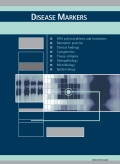Authors: Huang, Huiling | Mai, Weiyi | Liu, Dan | Hao, Yuantao | Tao, Jun | Dong, Yugang
Article Type:
Research Article
Abstract:
Objective: Oxidized LDL cholesterol (ox-LDL-C) is considered to be a key factor of initiating and accelerating atherosclerosis (AS). The purpose of this study is to elucidate the sensitivity and specificity of ox-LDL and oxidation ratio of LDL in the diagnosis of coronary artery disease (CAD). For the first time, we investigated the ratio of ox-LDL to ALB(ox-LDL/ALB). Methods and results: Blood ox-LDL, total cholesterol (TC), high density lipoprotein cholesterol (HDL-C), low density lipoprotein cholesterol
…(LDL-C), triglyceride (TG) and albumin (ALB) were measured in patients with acute myocardial infarction (AMI, n = 80), unstable angina pectoris (UAP, n = 80), stable angina pectoris (SAP, n = 80), normal control (n = 60), and dyslipidemia control (n = 60). Ox-LDL was measured by competitive ELISA. The level of ox-LDL and oxidation ratio of LDL(ox-LDL/TC, ox-LDL/HDL-C, ox-LDL/ LDL-C and ox-LDL/ALB) were significantly higher in each diseased group than controls (P < 0.001). In CAD group, ox-LDL and oxidation ratio of LDL in subjects complicated with hypertension (HT) and/or diabetes mellitus (DM) increased further (P < 0.001). Ox-LDL/ALB in the AMI group was 7 times higher than normal control group (0.068 ± 0.017 vs 0.009 ± 0.007, P < 0.001). The area under the curve (AUC) of receiver operating characteristic curve (ROC curve) is a criterium to evaluate the accuracy of diagnosing a disease. The AUC of ROC curve of ox-LDL/TC, ox-LDL/HDL-C, ox-LDL, ox-LDL/ALB and ox-LDL/ LDL-C for diagnosing CAD were 0.975, 0.975, 0.966, 0.966, 0.957 respectively (P < 0.001). When ox-LDL/TC = 0.175, the sensitivity and specificity of diagnosing CAD were 0.917 and 0.925, which were almost equal to each other, indicating that the rates of missed diagnosis and misdiagnosis for CAD were the lowest. Conclusions: The level of ox-LDL and the ratio of ox-LDL/TC, ox-LDL/LDL-C, ox-LDL/HDL-C and ox-LDL/ALB are better biomarkers than TC, TG, HDL-C and LDL-C for discriminating between patients with coronary artery disease and healthy subjects. And patients who have a high ratio of ox-LDL /TC may have a higher risk for CAD.
Show more
Keywords: Coronary artery disease, atherosclerosis, oxidized low density lipoprotein, cholesterol
Citation: Disease Markers,
vol. 24, no. 6, pp. 341-349, 2008
Price: EUR 27.50





